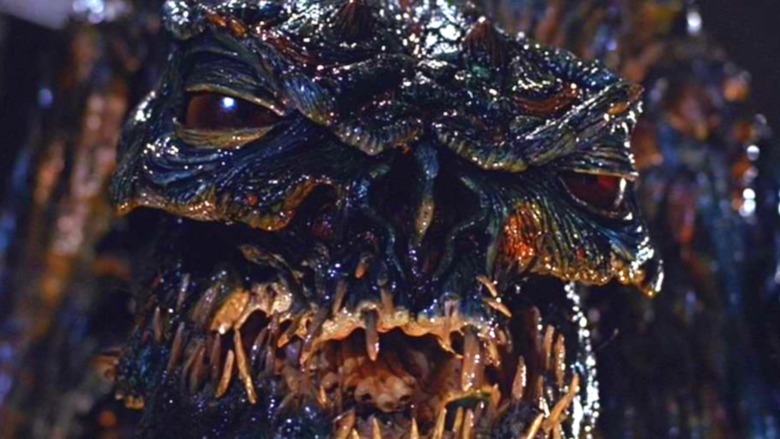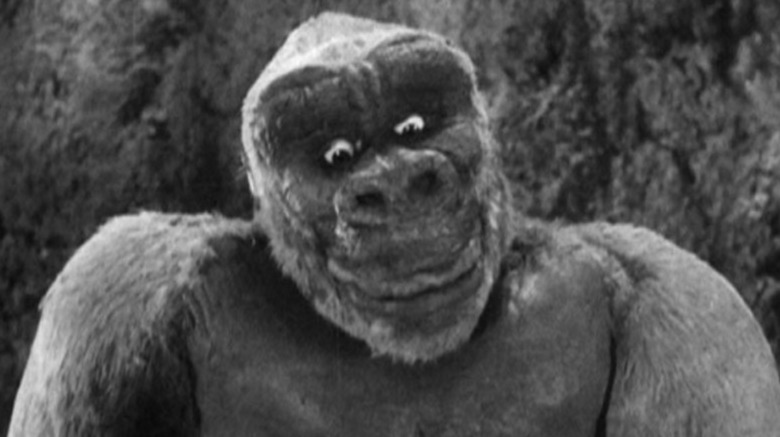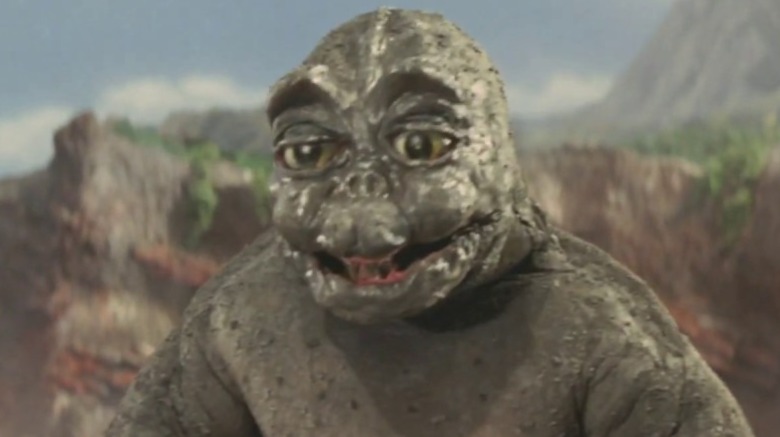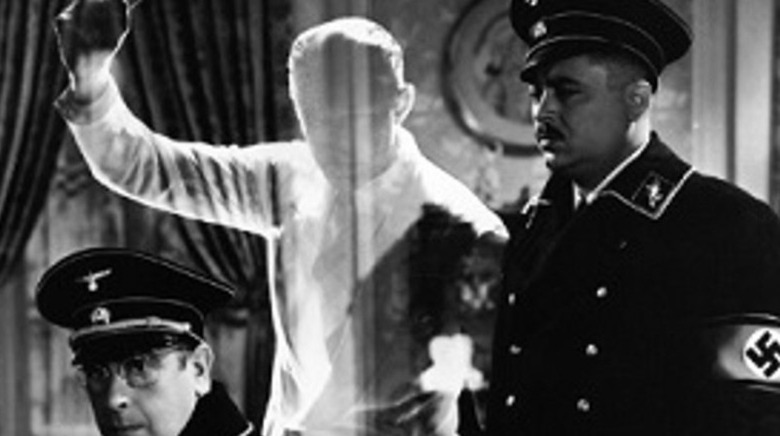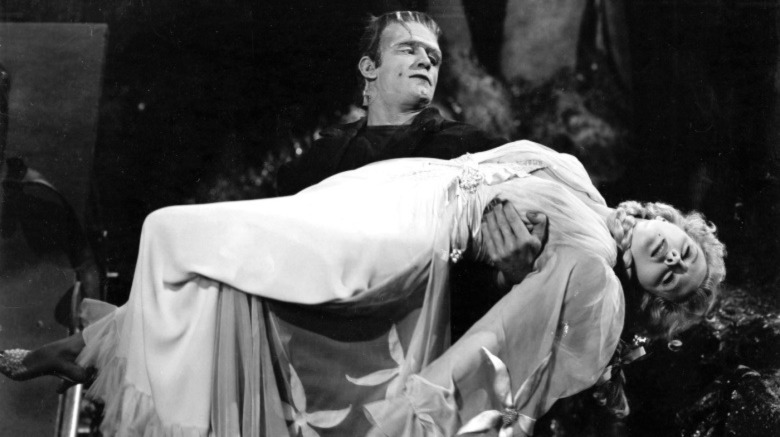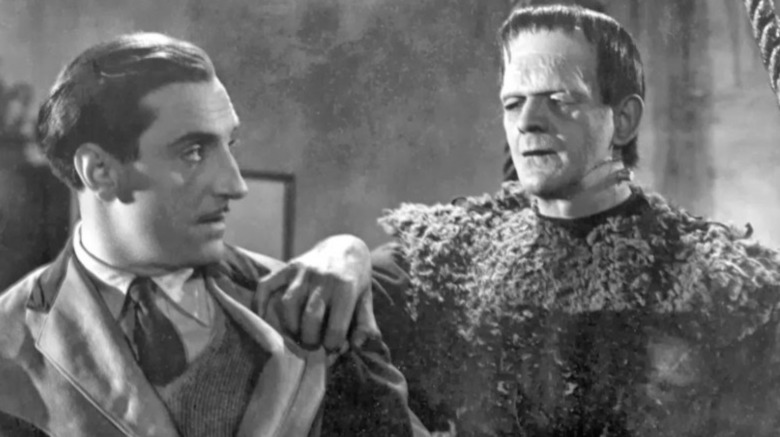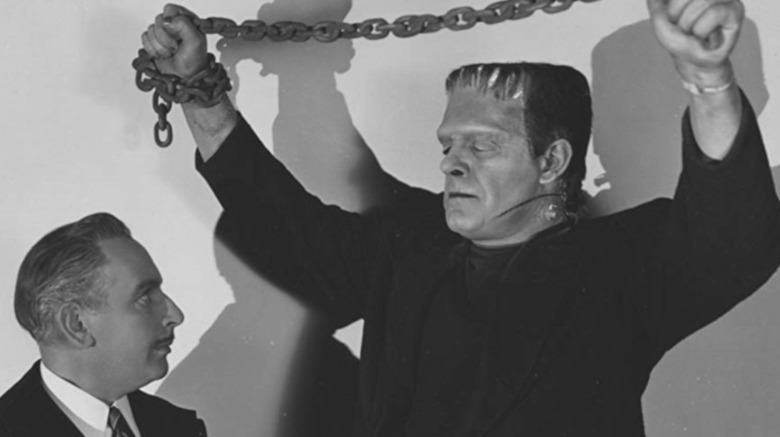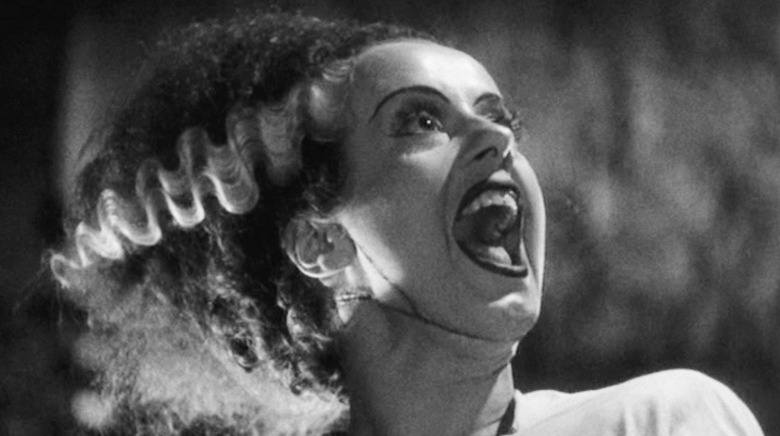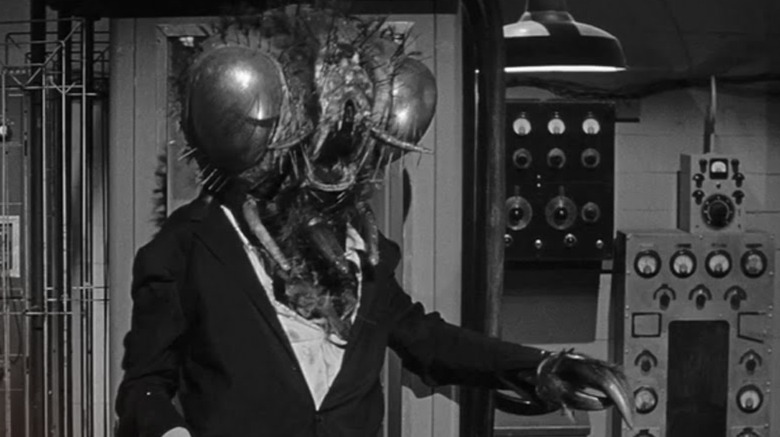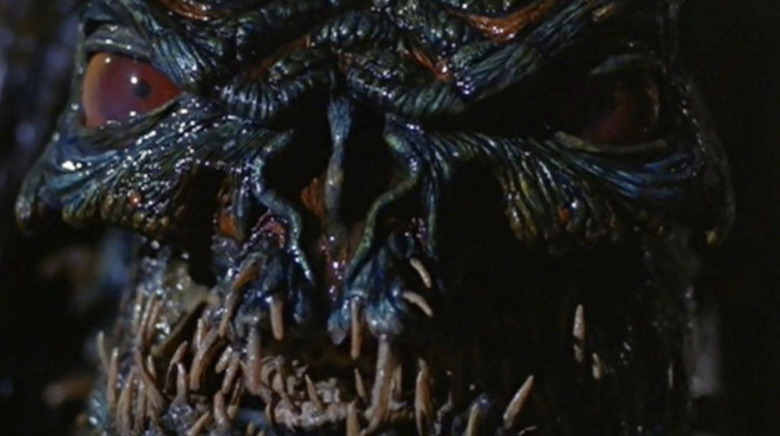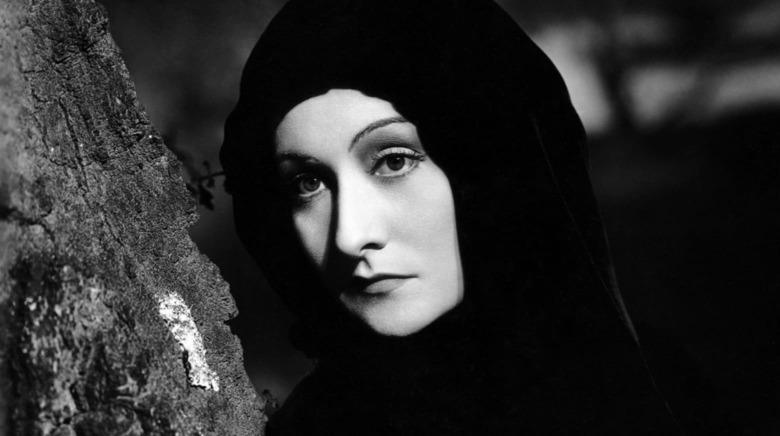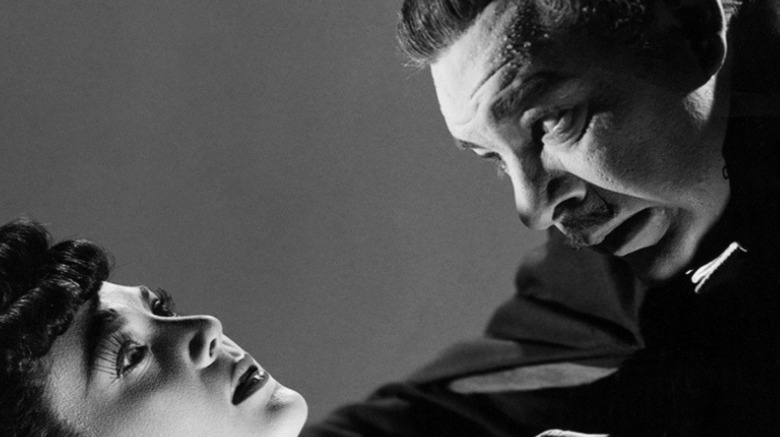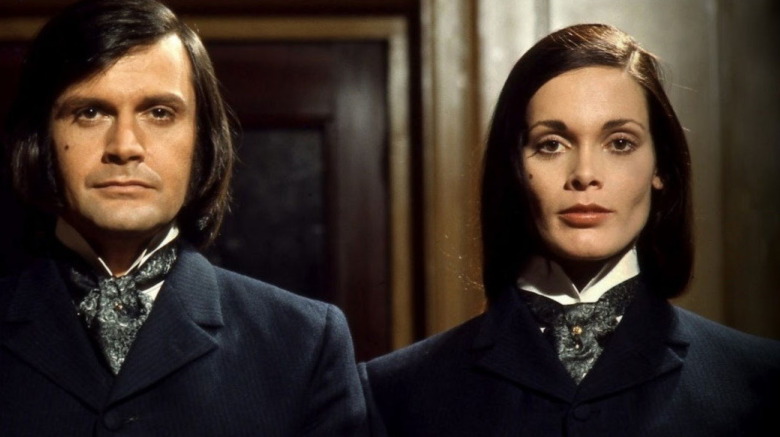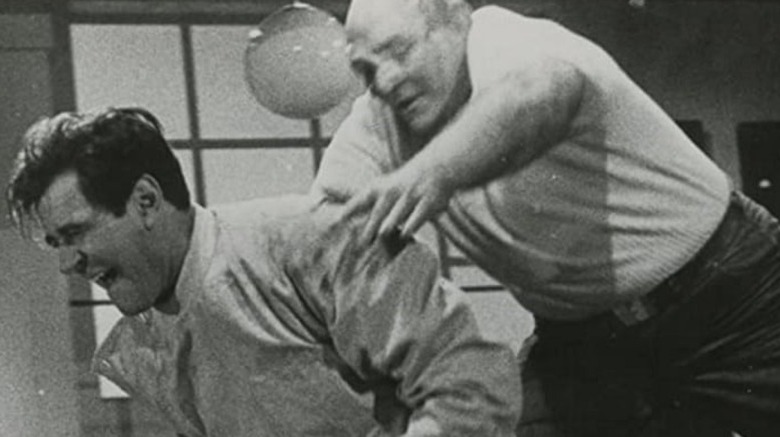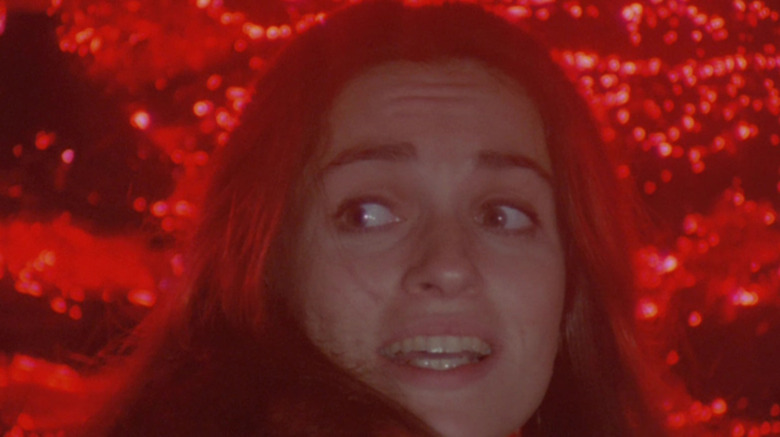Relatives Of Classic Movie Monsters Ranked Worst To Best
One thing about movie monsters: no matter how hard you try to kill them, they always come back. It doesn't matter if they're burned to death in a windmill, shot by silver bullets, or staked through the heart. Somehow, they manage to be restored to full health just in time for the sequel.
Sometimes though, the monsters take a breather and let their relatives take center stage for a while. This is particularly true of classic movie monsters in Universal Horror Films, RKO Pictures, Toho, 20th Century Fox, and Hammer films. For a while, it seemed as if every other monster movie featured the son, daughter, or second cousin of some horror movie favorite in the starring role.
So, we thought it would be fun to rank these relatives of classic movie monsters from worst to best. Of course, since "worst" in this case means a monster who's less effective than the original, be prepared to meet some less-than-evil relations before we get into the creatures who really manage to make their villainous parents and siblings proud.
The Son of Kong
The classic 1933 King Kong movie was a hit — so much so that RKO Pictures decided to write, produce, and release a sequel only nine months after the original debuted. Titled Son of Kong (1933), this movie runs only 69 minutes, making it barely a feature film. Nevertheless, it brings back several favorites, including stop-motion special effects wizard Willis O'Brien and Robert Armstrong, who reprises his role as Carl Denham, the man who captured Kong and brought him to New York.
In the story, Denham leaves New York to escape multiple lawsuits after King Kong's rampage. Getting a job shipping cargo around Asia, Denham makes his way back to Skull Island after an unscrupulous skipper (John Marston) claims the island also contains a hidden treasure. Denham and his love interest Hilda (Helen Mack) end up encountering a 12-foot-tall albino gorilla they nickname "Little Kong." The ape proves friendly and not only leads them to the treasure, but he also protects them from dinosaurs. At the end, "Little Kong" actually sacrifices himself to save Denham when a storm sinks the island.
In comparison to his "father," "Little Kong" is downright cuddly and heroic. Most depictions of King Kong, including his most recent turn in Godzilla vs. Kong (2021), manage to balance his savage and friendly sides, but "Little Kong" shows that some monsters ... just aren't monstrous.
The Son of Godzilla
The most popular versions of Godzilla emphasize the power and savagery of the King of Monsters — so it might come as a surprise that Godzilla's son is actually a goofy-looking dinosaur who blows smoke rings. First seen in Son of Godzilla (1967), "Minilla" was born from a giant egg and later adopted by Godzilla. Although the King of Monsters attempts to train Minilla on how to defend himself against giant mantises and a kaiju spider, Minilla is only able to actually breathe radioactive fire when his dad steps on his tail.
Minilla would appear in several other Godzilla films including All Monsters Attack (aka. Godzilla's Revenge) (1969) where he shows up as a friendly, human-sized kaiju in a little boy's dream. Minilla can talk to the boy in this form and gives him advice on how to stand up to bullies. This version of Minilla makes another appearance in Godzilla: Final Wars (2004) where he travels with a boy and his grandfather during a monster war.
Different Godzilla films showcase other versions of Godzilla's offspring, including the savage "Baby Godzillas" that appear in the 1998 U.S. Godzilla movie. During Toho's "Hisei" era, a "Little Godzilla" was also introduced in Godzilla vs. Mechagodzilla II (1993). Over the course of several films, this Godzilla grows larger until he absorbs his father's radiation and becomes an adult Godzilla. Despite this, the classic Minilla is a mostly kid-friendly creation who can do some damage — but usually doesn't want to.
The Grandson of the Invisible Man
The Invisible Man had his own Universal Monster franchise, beginning with The Invisible Man (1933) featuring Claude Rains' memorable performance as insane and unseen scientist Jack Griffin, who terrorizes an English village. Although Griffin dies at the end of the movie, invisible characters continued to appear (sort of) in six more Universal films.
In most of these later films, an unrelated character takes the invisibility serum and becomes a new Invisible Man (or woman). Jack Griffin's brother Frank (John Sutton) does appear in The Invisible Man Returns (1940), but he only gives the serum to another man — Sir Geoffrey Radcliffe (Vincent Price) who becomes the main character.
However, one Invisible Man, Frank Griffin Jr. (Jon Hall), from The Invisible Agent (1942) is established as the grandson of the original Invisible Man. Entrusted with his grandfather's formula, Frank works with the U.S. government during World War II to become an invisible spy and sabotage Axis war efforts behind enemy lines. While this Invisible Man is more heroic than his grandfather, he spouts a lot of cringe-worthy anti-Japanese sentiments that would shock most modern audiences.
Hall would return to play invisible madman Robert Griffin in The Invisible Man's Revenge (1944). Strangely, while this new character shares Jack Griffin's surname, he doesn't appear to be related.
Frankenstein's Granddaughter
So let's get this out of the way: This list is supposed to be about the relatives of monsters, and not their creators. However, the family members of the infamous Doctor Frankenstein are, indeed, the Monster's relatives. That's because the Monster is Frankenstein's created "son." More importantly, the members of the Frankenstein family really are the true monsters for the way they keep torturing the poor creature. With that out of the way, let's visit our first cursed extended member of the Frankenstein clan...
Elsa Frankenstein (Evelyn Ankers) — the daughter of Ludwig Frankenstein (Cedric Hardwick) and granddaughter of Doctor Henry Frankenstein (Colin Clive) — first shows up in The Ghost of Frankenstein (1942). Initially ignorant of her family history, Elsa discovers the Frankenstein journals and learns about the Monster. While she begs her father not to revive the creature, she's unable to stop his experiments.
Elsa shows up again in Frankenstein Meets the Wolf Man (1943), this time played by Ilona Massey. Now a baroness, Elsa meets Larry Talbot (aka the Wolf Man) who wants to learn Frankenstein's secrets of life and death and end his cursed life. Elsa directs Larry and scientist Doctor Mannering (Patrick Knowles) to a journal containing her grandfather's secrets. She also uses her wealth to rebuild the Frankenstein laboratory, hoping Mannering can destroy the Monster (Bela Lugosi) and the Wolf Man. Instead, Mannering makes the Monster stronger and he attacks Elsa, but the Wolf Man saves her.
Unlike her other family members, Elsa has no interest in playing God and only wants to destroy her family's work. However, her actions still lead to a lot of tragedy, making her a reluctant participant in the Frankenstein legacy.
The Son of Frankenstein
While Doctor Henry Frankenstein stopped making monsters after Bride of Frankenstein (1935), the mantle was later picked up by his son Baron Wolf von Frankenstein (Basil Rathbone) in the 1939 Universal horror film Son of Frankenstein. While Wolf doesn't seem as crazy as his dad, he's later manipulated into reviving the Monster (Boris Karloff) by the mad graverobber Ygor (Bela Lugosi), stupidly thinking this will somehow improve his family's reputation.
Naturally, this goes horribly wrong and Ygor just uses the Monster to murder his own enemies. Baron Frankenstein manages to shoot Ygor and kick the Monster into a pit of molten sulfur. In the end, the villagers all cheer for Frankenstein ... but that might only be because he's leaving town.
In terms of evil, Baron Wolf von Frankenstein doesn't seem to be that bad a guy — he even becomes a swashbuckling hero at the end of the movie to save his young son Peter (Donnie Dunagan). However, considering how easily he was convinced to bring the Monster back to life, his judgement is definitely impaired.
The OTHER Son of Frankenstein
Fittingly, for a mad scientist obsessed with creating life, Doctor Henry Frankenstein had a lot of kids. In The Ghost of Frankenstein (1942), we meet the doctor's younger son, Doctor Ludwig Frankenstein. We also learn that both the graverobber Ygor and the Monster (Lon Chaney Jr.) survived their apparent deaths in Son of Frankenstein and decide to visit Ludwig for help in healing the Monster.
This time, however, Ludwig also gets a third visitor — the ghost of his father (also played by Cedric Hardwicke). After receiving an Obi-Wan-Kenobi-style pep talk from his dad, Ludwig is convinced he can reform the Monster by transplanting a new brain into his skull. Unfortunately, Ludwig accidentally gives the Monster Ygor's deranged brain and makes the creature more dangerous than ever.
Prior to The Ghost of Frankenstein, the Monster was largely seen as innocent and childlike. However, after getting Ygor's brain, the Monster becomes more of a killing machine and a tool for other madmen to use. Considering this was all thanks to Ludwig, this son of Frankenstein is easily the worst of the doctor's offspring.
Bride of Frankenstein
While they never did get to officially tie the knot, Frankenstein's Monster (Boris Karloff) and his Bride (Elsa Lanchester) certainly became one of cinema's most iconic couples for the few minutes they had together in Bride of Frankenstein (1935). The creation of Doctor Henry Frankenstein (Colin Clive) and Doctor Pretorius (Ernest Thesiger), the "Bride of Frankenstein" was stitched together from female cadavers to be a mate for Frankenstein's original Monster.
Despite the fact that she's the title character, the Bride only appears at the very end of the film when Frankenstein and Pretorius bring her to life using the same equipment that shocked the original Monster into existence. As the Bride takes her first hesitant steps, her lonely suitor approaches his intended mate ... only to hear her shriek when she sees his deformed face. Crushed, the Monster decides to end their lives by overloading the lab's equipment and blowing them all to atoms.
Considering her entire second life lasted only a handful of minutes, the Bride didn't get a chance to wreak a lot of havoc. Nevertheless, she did manage to perform one act of lasting damage — she broke the heart of one of cinema's most sympathetic monsters. While instinctive, her rejection of the Monster likely led to his more vindictive persona in later films.
The Son of the Fly
The original 1958 science fiction film The Fly is considered a horror classic about scientist Andre Delambre (Al Hedison) who invents a teleportation machine, but gets his body parts mixed up with a housefly and ends up with a gigantic fly head and insect claw. While he doesn't hurt anyone, he ultimately commits suicide by having his wife crush his head and claw beneath a hydraulic press.
In 1959, 20th Century Fox came out with The Return of the Fly, which sees Andre's adult son Philippe (Brett Halsey) continue his father's experiments and create a more reliable teleporter. When his partner (David Frankham) turns out to be an industrial spy, Philippe is forced into a recreation of his father's original accident and emerges as another fly-headed man. This time, he tracks down the spy and his partner and kills them — but gets a lucky break when his friends manage to reintegrate his atoms and restore his humanity.
While this version of the Fly is a killer, he's not exactly an unthinking monster. Considering that the film ends more happily than the first story, he's not even the tragic figure his father was, making him a weak copy of the original.
The OTHER Son of the Fly
The original 1958 version of The Fly may have been a creepy film, but it doesn't approach the levels of body horror shown in its 1986 The Fly remake starring Jeff Goldblum. In this version, Goldblum's Seth Brundle manages to fuse himself with a fly at a genetic level, causing his body to slowly crumble and mutate into a giant human-fly hybrid he dubs "Brundlefly." After a failed attempt to fuse himself with his girlfriend Veronica (Geena Davis) results in Brundlefly's death, the nightmare appears to be over — but it turns out Veronica is pregnant with Seth's child.
In The Fly II (1989), we meet Martin Brundle (Eric Stoltz), an apparently normal human with a genius intellect — but also a rare genetic disorder that causes him to reach full maturity by age five. Manipulated into perfecting his father's work (and possibly finding a cure for his accelerated aging), Martin discovers his body has some other cruel surprises when he mutates into a new version of Brundlefly.
This Brundlefly is healthier and stronger than his father, allowing him to rip through an entire security force with disturbing ease. He's also willing to swap his mutated genes with a corrupt businessman (Lee Richardson) and regain his human form while turning his donor into a giant maggot-like monster. However, he also retains some of his humanity and refuses to harm innocent people or animals, showing he's not as ruthless as his old man.
Dracula's Daughter
The first sequel to Dracula (1931) chose not to resurrect Count Dracula but instead introduced audiences to his daughter, the vampiric Countess Marya Zaleska (Gloria Holden) in Dracula's Daughter (1936). Shortly after her father is killed by Professor Van Helsing (Edward Van Sloan), Marya steals her father's undead corpse and performs a ritualistic cremation. Marya hopes the ritual will end her own curse, but she remains a vampire and starts hunting new victims, often with the help of her manservant Sandor (Irving Pichel).
Despite this, Marya develops genuine feelings for psychiatrist Dr. Jeffrey Garth (Otto Kruger) and attempts to use his help along with her will in overcoming her vampiric urges. Eventually, however, she gives in to her dark side and tries to turn Garth into a vampire. She's eventually killed by Sandor before she can go through with the deed.
For all her wicked acts, Dracula's daughter does make attempts to fight her curse, making her one of the original conflicted vampires who precede Angel (David Boreanaz) of Buffy the Vampire Slayer. Another infamous scene of Marya painting a partially undressed female model contains a surprising amount of LGBT subtext for its time that later vampire films explored to a greater extent. While not as well-known as her father, Dracula's Daughter is a trailblazer for modern vampires.
The Son of Dracula
Interestingly, while Universal produced three solo Dracula films, only the first one starred Bela Lugosi as the original Count Dracula. The other two feature Dracula's offspring, starting with his daughter and then his son Count Alucard (Lon Chaney Jr.) in Son of Dracula (1943). Dracula would return in other Universal Horror films (played by both John Carradine and Lugosi), but his franchise is unique in that audiences had to get used to a different vampire in the first three films.
Unlike his sister Countess Marya Zaleska, Chaney's Count Alucard seems to have no problem being an evil vampire. He seduces and marries a wealthy woman (Louise Allbritton) then turns her into a vampire. He also feeds on other living victims, but is undone by his new wife who tells her ex-boyfriend how to kill the vampire. In the end, Alucard reveals that while he possesses his father's cruelty, he's lousy at choosing brides and even worse at hiding his identity. "Alucard" is just "Dracula" spelled backwards after all.
Dr. Jekyll and Sister Hyde
In 1971, Hammer films came up with a unique take on the classic Jekyll/Hyde tale when they released Dr. Jekyll and Sister Hyde. The film stars Ralph Bates as Doctor Jekyll who attempts to create the elixir of life. Reasoning that women live longer than men, Jekyll creates a serum using female hormones from cadavers and gives himself a sex change by transforming himself into his "sister" Edwina Hyde (former Bond girl Martine Beswick).
From there, things get crazier. Jekyll needs to kill more young girls in order to get the hormones to keep the serum's effects — but when the evil Edwina tries to kill Jekyll's love interest Susan (Susan Brodrick), Jekyll's persona reasserts itself and saves her. Sister Hyde ends up falling to her death and mutates into a male/female corpse.
One of the weirder entries on this list, Dr. Jekyll and Sister Hyde manages to convey the classic good/evil dynamic of the source material with a gender-bending twist. The concept was revisited in the 1995 comedy Dr. Jekyll and Ms. Hyde (starring Tim Daly and Sean Young as the dual personas), but the original Hammer film remains the creepiest version of this twisted reimagining.
The Grandson of the Fly
One of the most obscure monsters on this list, Martin Delambre (George Baker) is the grandson of the original Fly and the star of Curse of the Fly (1965), the third and final film in the original The Fly franchise. While the film follows certain narrative elements from the previous two films, it's unique in that nobody turns into a fly-headed monster.
However, Martin does have some creepy traits — thanks to his grandfather's experiments, he has fly genes that make him age rapidly. To control his excessive aging, he uses a serum to keep himself young and also continues his grandfather's experiments with his father Henri. However, many of their teleportation test subjects end up horribly disfigured and Martin and Henri keep them locked in a barn. Eventually, they try to eliminate all evidence of the experiments, but Martin starts aging rapidly and dies.
Where most Fly characters are sympathetic, both Henri and Martin can be quite callous and even mutilate Martin's wife in an experiment. Traces of this story can be seen in the 1989 film The Fly II which follows the David Cronenberg remake of The Fly (1986) and features a descendant of the Fly named Martin who suffers from rapid aging. But unlike his predecessor, Stoltz's Martin maintains a level of humanity even as a fly-creature, making the original Martin the bigger monster.
The Son of the Blob
Among movie monsters who can rack up an impressive body count, The Blob is near the top of the list. This gelatinous alien creature does nothing but ooze over people and animals, growing in size as it consumes them. The bigger it gets, the more people it can eat — making it one problem that just keeps getting worse and worse.
Luckily, teenager Steve Andrews (Steve McQueen) and his friends were able to freeze the alien creature in the original film The Blob (1958) and render it inert, but you can't keep a monster like that down forever. In the 1972 sequel Beware! The Blob (also titled Son of the Blob), a person who works as a layer of oil pipeline journeys to the North Pole and stupidly brings back a piece of the Blob from its arctic prison. The piece thaws and devours an adorable kitten before moving on to chickens, horses, and people, soon growing into a massive copy of its original parent.
Since this new Blob is basically a regenerated version of the original, it's just as dangerous and destructive. In the end, it gets frozen too, but a piece breaks off and thaws out, starting the process all over again. As the son of the Blob can now overcome its main weakness, it's one of the few movie monster relatives that's actually more dangerous than the original. Plus, it kills a cute kitten. And that's horrible.
